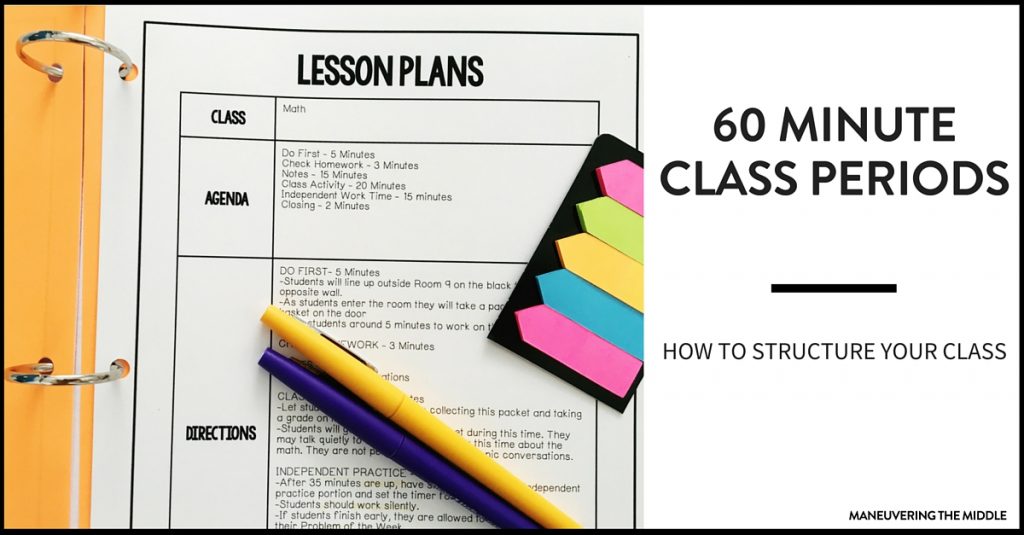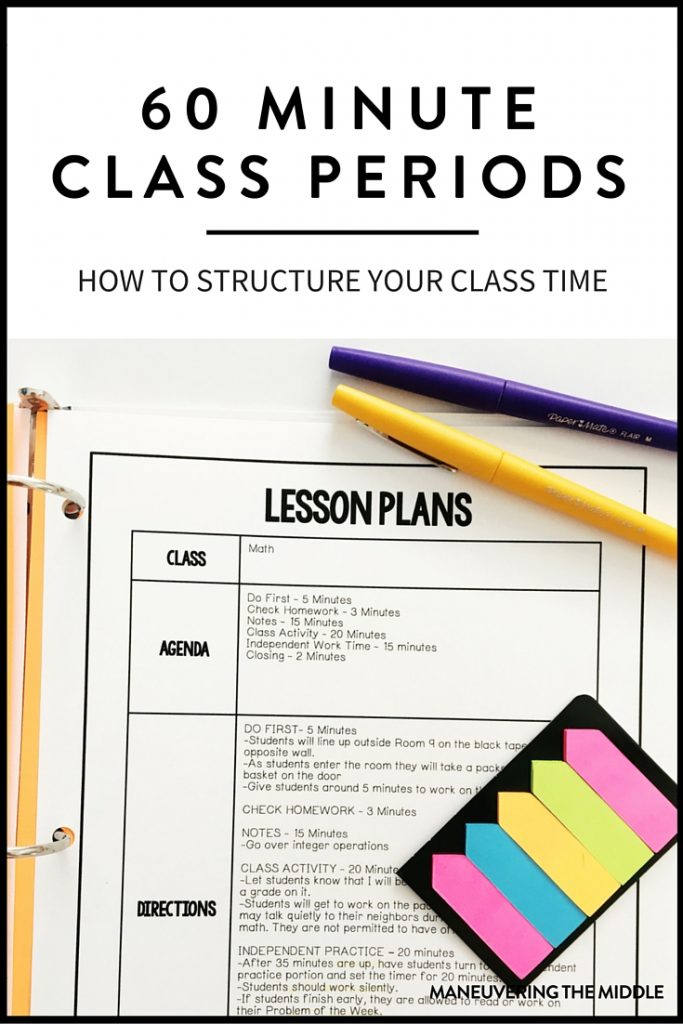HOW TO STRUCTURE A 60 MINUTE CLASS PERIOD
How long are your class periods? This year I had 75 minute class periods. It was glorious! In prior years, I have had 50, 60, 75, and 100 minute class periods. 50 felt like a race against the clock every day; 100 minutes was long enough to watch every students’ eyes glaze over in boredom. My proverbial Goldilocks situation leads me to the belief that anywhere between 60-75 minutes is perfect. Today, I am going to go over how I would structure a 60 minute class period.
HOW TO STRUCTURE A 60 MINUTE CLASS PERIOD
These of course are guidelines; sometimes albeit often, in a middle school classroom, things do not go according to plan, but it is always a good idea to have a structured routine for both yourself and your students.

WARM UP: 5 – 10 MINUTES
You might also refer to this as the “do first” or “bell ringer”, either way they all set the stage for a productive class period. One thing that I gained from reading The First Days of School is to communicate to students that the bell, nor does the teacher start the class, but YOU (the student) starts class. Students come in, write down their homework, get out listed materials, and begin their warm up. (You can see how I remind students of this routine here.) This is the time where I check in with the previous day’s absent students, check to make sure homework is complete, and take attendance all while students are silently working.
The warm up has to be something that 80% of students can complete 80% of the assignment without any help. A huge frustration for teachers and students is if a warm up is too challenging or has complicated directions. The important part of the warm up is that students get straight to work. For the first 4 weeks of the school year, I stick to multiplication and division facts. I put a timer on when the bell rings for 5 minutes and project it. When the timer goes off, I spend the next 3-5 minutes either going over the warm up, going over last night’s homework, or a combination of both.
HOOK: 2 MINUTES
This is the time I use to invest students in what they are learning that day. If the objective is solving for rates, I might show a video of Usain Bolt running the 100 meter dash, and tell students that by the end of class, we will be able to calculate his speed. Sometimes I am not as fancy, and I have students turn and talk to their neighbor about what we learned yesterday or review the vocabulary introduced within the unit.
GUIDED NOTES: 10 – 15 MINUTES
My mentor teacher use to always reference the concept of movement and keeping things changing for students, likely after sitting through a rough lesson during my first year.  The rule of thumb is that notes should not take longer than 1 plus your students’ age, so if you teach 12 year olds, notes should last no longer than 13 minutes (12+1). Students are only capable of active listening for so long. And by students, I mean everyone.
The rule of thumb is that notes should not take longer than 1 plus your students’ age, so if you teach 12 year olds, notes should last no longer than 13 minutes (12+1). Students are only capable of active listening for so long. And by students, I mean everyone.
 The rule of thumb is that notes should not take longer than 1 plus your students’ age, so if you teach 12 year olds, notes should last no longer than 13 minutes (12+1). Students are only capable of active listening for so long. And by students, I mean everyone.
The rule of thumb is that notes should not take longer than 1 plus your students’ age, so if you teach 12 year olds, notes should last no longer than 13 minutes (12+1). Students are only capable of active listening for so long. And by students, I mean everyone.
I spend about 2 minutes teaching any vocabulary that they will need for that day. I model a ‘think aloud’ on a easy level problem under my document camera. Then I use another easy problem, but ask students guiding questions, (checks for understanding) so they are the ones solving the problem. These two easy problems take around 5 minutes. Depending on the concept, we then solve medium/difficult problems in the same manner. At this point, I am asking questions, giving adequate wait time, and moving around the room to see specific students work. Sometimes, I use a number cube to call on students to ensure they are mastering the skill with less and less help from me. Other times, I have them check with their table, discuss, and share with the class. By moving around and cold calling on students, I am able to determine who needs to be in my small group. Ideally, this takes 5-8 minutes.
If time allows, I love to incorporate a more difficult question that I would expect only about three quarters of my students to be able to solve without my help. I ask my students to try to solve it on their own. While students are solving, I use this time to pass out the activity or classwork. When I am passing out the classwork, I take a peek at how students are doing and decide whether we should go over the problem.
CLASS ACTIVITY: 20 MINUTES
This is the time period where students are engaging with the work in pairs or at their tables. This is also when I am pulling small groups. Before I pull small groups though, I typically circulate to ensure that everyone has started, answer clarifying questions, and I give rewards to students who are showing strategies and working hard. If an activity seems more difficult or like students need more assistance, I might forgo small groups or form a small group to work together and stick nearby.
The classwork could be a card sort, matching activity, scavenger hunt, white board practice, a game, or station work. My favorite activities are when students complete math problems to solve a riddle. This time period has been made increasingly less challenging for me by giving students a mixed answer key. Students solve a problem, and can find their answer among a list of 10 other answers which eliminates students raising their hands just to ask “did I get it right?” Students can see that they solved the problem correctly because they got an answer provided. This doesn’t have to be on their worksheet or in a riddle, you could write 10 answers mixed up on the board.
What is important here is that you have more work than what can get done in the time period or you have an extension activity that students know where and how to get. I used to get so frustrated when I was trying to work with struggling students, and I had fast workers who were finished and now either asking me what they should be doing or distracting those who had not yet finished.
***If you have a 45-50 minute class, this is the time where it gets a little sticky. Between cleaning up and closing, it might be difficult to assign independent practice. When I had 50 minutes, I always aimed to have students work on the homework for at least 5 minutes. This gave them a good start, aka more likely to finish, and I was able to answer questions and make sure everyone was on the right track.
INDEPENDENT PRACTICE/EXIT TICKET: 15 MINUTES
The goal is that by the end of class, all of my students can practice the skill without any support from me or their teammates. I want students to be able to use what they already know to think critically and PRESERVE independently. This is the work that I will check or grade as a formative assessment and decide whether I need to go over this skill again. At this time, my small groups are still working with me, but I have scaffolded, so that I am only stopping them if I see something being practiced incorrectly. During this time, I do allow students to reference their notes.
CLOSING: 1 MINUTE
During this time, I ask for exit tickets to be stacked in a neat pile at their table, and I dismiss tables according to who is packed up and ready to go. I like to have students refer to the objective and summarize their learning in a couple of sentences, too. If we are running ahead of schedule, we might complete a quick trade and grade, so students can receive immediate feedback and save me time grading.
I got tired just thinking about these classes! They go so quickly and then you turn around and do it again and again. How long are your classes? How do you spend your time?

No comments:
Post a Comment